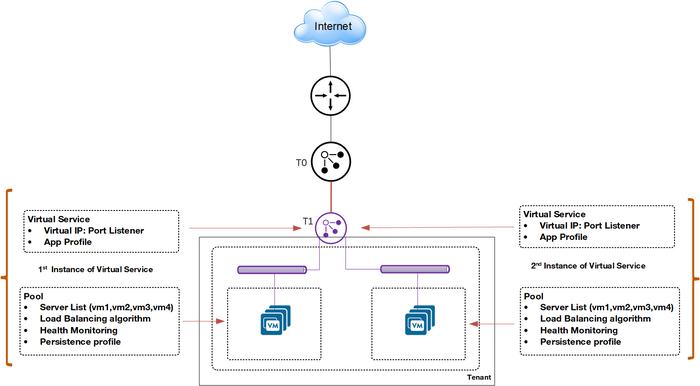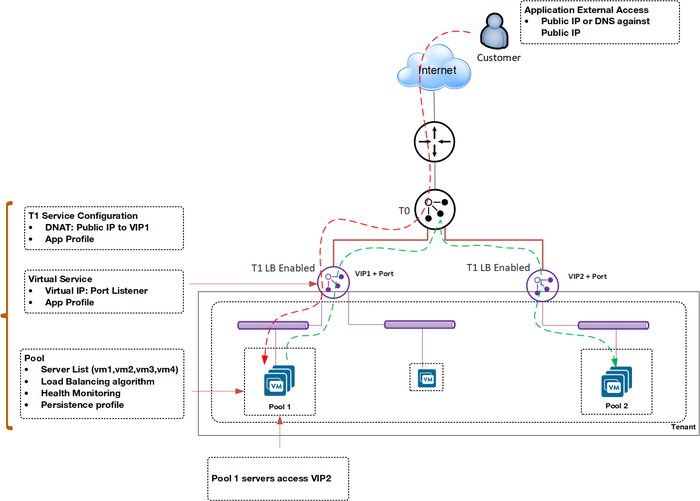LoadBalancer As A Service
The load balancer service in Cloud Avenue is provided by VMware’s NSX Advanced Load Balancer (NSX ALB) solution.
The implementation is carried out at the T1 gateway level in a vDC or a “Data center group ” (i.e., a group of multiple vDCs) if they are connected to the same T1 gateway within the same AZ (Chartres or Val de Reuil).
You can create/manage the load balancer configurations from the tenant user interface (vCloud Director – VCD portal).
Advanced Load Balancer – Shared and Dedicated
| Type of LBaaS | Configuration Requirements | Default Service Class Quota | Load Balancing Engine Resilience |
| Shared | T0 VRF Premium | 20 VIPs | Active/StandbyActive/Active |
| Dedicated | T0 VRF Premium | 200 VIPs | Active/StandbyActive/Active |
The available load balancer services on Cloud Avenue Private (“VCOD”) are as follows:
| Type of LBaaS | Configuration Requirements | Default Service Class Quota | Load Balancing Engine Resilience |
| Dedicated | T0 Dedicated Medium | 200 VIPs per Service Engine | Active/StandbyActive/Active |
| Configuration Parameters | IaaS with vDC | IaaS with vCoD |
|---|---|---|
| Application Type | ||
| HTTP | ▲ | ▲ |
| HTTPS | ▲ | ▲ |
| L4 TCP | ▲ | ▲ |
| L4 UDP | ▲ | ▲ |
| L4 TLS | ▲ | ▲ |
| Load Balancing Algorithm | ||
| Least Connections | ▲ | ▲ |
| Round Robin | ▲ | ▲ |
| Consistent Hash | ▲ | ▲ |
| Fastest Response | ▲ | ▲ |
| Least Load | ▲ | ▲ |
| Pool Persistence | ||
| HTTP Cookie | ▲ | ▲ |
| Custom HTTP Header | ▲ | ▲ |
| Application Cookie | ▲ | ▲ |
| Active Health Monitor | ||
| TLS | ▲ | ▲ |
| HTTP | ▲ | ▲ |
| HTTPS | ▲ | ▲ |
| Analytics | ||
| Dashboard | ▲ | ▲ |
| Advanced Features | ||
| HTTP Policy | ▲ | ▲ |
| WAF | ▲ | ▲ |
Note!
If you wish to benefit from the IP address preservation function, you must specify your requirement. The IP address preservation function is only available with the Active/Standby resilience of the load balancer. By using the “Preserve Client” function, the source IP address is preserved for packets arriving at the load balancer.
Load Balancer Configurations
General Load Balancer Schema
A load balancer option is available on the T1 gateway.
You can create:
● Virtual Services: A virtual service is a combination of an IP address and a port that uses a single network protocol. A virtual service listens for traffic to an IP address. It processes client requests and directs valid requests to a member of the load balancer server pool.
● Pools: A server pool is a group of one or more servers that you configure to run the same application and ensure high availability.
● Application Profiles: Application profiles determine the behavior of virtual services based on the application type. Application profile types, such as HTTP, HTTPS, L4 TCP, L4 UDP, L4 TLS, can be used.

External and Internal Load Balancer
Depending on configuration requirements, you can deploy the load balancer for both internal and external applications.
In this example, Pool 1 runs an externally-facing application. The servers in Pool 1 access Pool 2, which runs an internally-facing application.

Upgrade
Cloud Avenue Shared: Number of Virtual Services
If you need to create additional load balancers beyond those assigned by default when opening your tenant, you can request an additional virtual services pack.
Note!
Changing the Advanced Load Balancer from Shared to Dedicated is impactful. A new configuration of your load balancer will be required.
Cloud Avenue Private: Service Unit Counting (cores)
The client can request an upgrade for the load balancer engine, meaning an increase in the number of engine cores (vCPU). By default, your load balancer engine is provisioned with the number of cores requested in your order form.
Note!
Changing the number of load balancer engine cores (vCPU) is an impactful process.
| Cloud Avenue Shared | If you have the Cloud Avenue Shared offer, you will have by default the vCloud Director tenant management portal as a self-service interface to create/manage virtual services with associated advanced features such as HTTP Policy or WAF. |
| Cloud Avenue Private |
If you have the Cloud Avenue Private offer, the available interface types depend on the options you have chosen, especially if you have not selected the vCloud Director tenant management portal option: ● If you have opted for vCloud Director, you will use it to create/manage virtual services with associated advanced functions such as HTTP Policy, WAF. ● If you have not opted for vCloud Director, you will have access to the NSX Advanced Load Balancer interface to create/manage virtual services in your tenant with associated advanced features such as HTTP Policy, WAF. |
Advanced Features
| Category | Description |
|---|---|
| HTTP Policy |
The HTTP policies of virtual services allow controlling security, client request attributes, and application response attributes. 
|
| Web Application Firewall (WAF) |
The Web Application Firewall (WAF) can be enabled for a virtual service. Two WAF modes are available: Detection Mode and Enforcement Mode. 
|